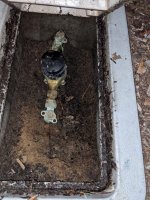Niccolo
Member
A working PRV should hold the outlet pressure essentially constant (well, prevent it from exceeding the set value because of a supply pressure rise). It also acts like a check valve, so any thermal expansion has nowhere to go. That's why you also need an expansion tank. Setup properly, even with thermal expansion, the pressure won't rise more than a couple of pounds, if that (the water expands into the tank). Otherwise, the pressure will easily exceed 150-psi, at which point, if there are no other leaks to prevent it from getting that high, the safety valve on the water heater will open. MOst supply lines are quite rigid, so expansion immediately creates a pressure rise.
If your pressure didn't rise after hot water use and you weren't using water otherwise, then there's no check valve (the water pushed back into the supply), and likely, no ET. IF, otherwise, the pressure did spike, it was probably because the utility raised the pressure. You could get a spike if there was a high rate of flow and a quick acting valve closed as it rebounds off the the valve (a water hammer situation).
Yeah, all day long the pressure fluctuated between 53 and no more than 58 PSI (assuming my gauge is to be believed), even with the hot water heater sporadically coming on.
I'm curious to see whether it spikes to ~140 PSI again tonight. EDIT: Spike to 180 PSI overnight, if the tattletale hand is to be believed!
I do not have an expansion tank.
Sounds like there's not a check valve.
Sounds like there either isn't a PRV or if there is it isn't set up properly. Where would a PRV typically be located, i.e. where would I look for it and, assuming I don't have one, where might one get installed?
I'm inferring than an expansion tank wouldn't help with my apparent utility-imposed pressure spikes, only a PRV would help with those (but a PRV would necessitate an expansion tank).
EDIT: Found my water meter in a box near the street, photo attached. Can one infer anything about a possible check valve or PRV from that photo? I'm guessing it's just a water meter.
Attachments
Last edited:

